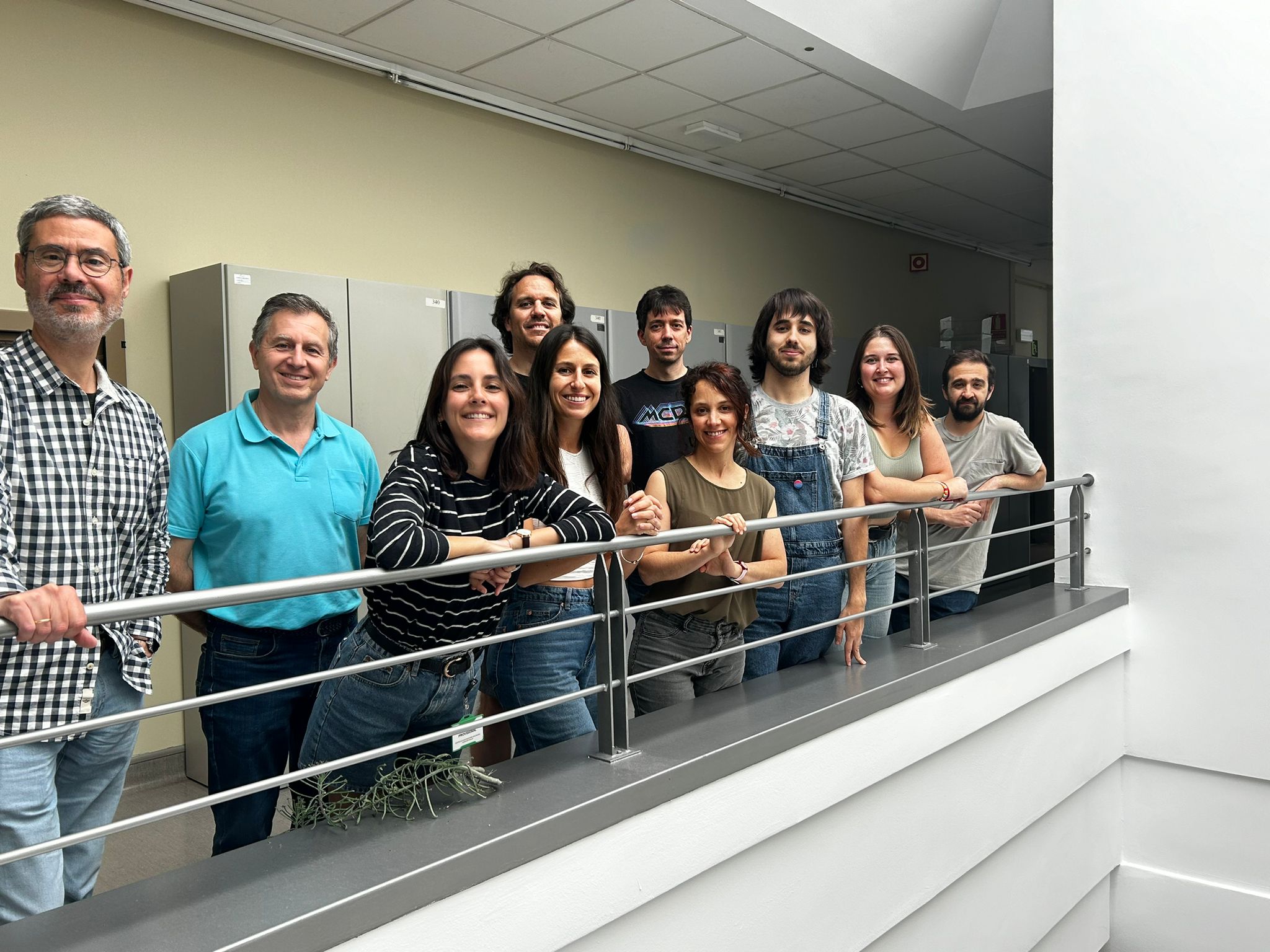Responsable/s del laboratorio
IP/s del Grupo
intro
Nuestro grupo estudia las redes metabólicas y de regulación que controlan el metabolismo bacteriano de compuestos tóxicos y/o de desecho, muchos de ellos importantes contaminantes medioambientales. Los sistemas de señalización celular y los mecanismos de resistencia asociados e implicados en la adaptación bacteriana al estrés ocasionado por los compuestos tóxicos también son objeto de estudio. Para tener una visión integradora realizamos abordajes clásicos de fisiología, bioquímica y biología molecular, combinándolos con técnicas ómicas y modelos metabólicos in silico. Los conocimientos adquiridos son utilizados para el diseño mediante ingeniería metabólica de sistemas de microorganismos recombinantes como biofactorías para la conversión de contaminantes/desechos en productos de valor añadido. El desarrollo de tecnologías sostenibles que permitan la revalorización de contaminantes y residuos biológicos se enmarca dentro de la moderna economía circular.
Miembros
| Eduardo Díaz Fernández |
| Manuel Carmona Pérez |
| Carlos del Cerro Sanchez |
| Unai Fernández Arevalo |
| Helena Gomez Alvarez |
| Gonzalo Durante Rodríguez |
| Ana Valencia Hernando |
| Sofia de Francisco de Polanco |
| Carla Sevilla Navarro |
| Sergio Vivo Filardi |
| Yolanda Gonzalez Perez |
| Elena Alonso Fernandes |
| Julia Marti Pages |

Publicaciones seleccionadas
Durante-Rodríguez G, de Francisco-Polanco S, García JL, Díaz E [2024]. Characterization of a MHYT domain-coupled transcriptional regulator that responds to carbon monoxide. Nucleic Acids Res. 52(15):8849-8860
Fernández-Arévalo U, Fuchs J, Boll M, Díaz E [2024]. Transcriptional regulation of the anaerobic 3-hydroxybenzoate degradation pathway in Aromatoleum sp. CIB. Microbiol Res. 288:127882
Durante-Rodríguez G, de Francisco-Polanco S, Fernández-Arévalo U, Díaz E [2024]. Engineering bacterial biocatalysts for the degradation of phthalic acid esters. Microb Biotechnol. 17(10):e70024
Castro, L., Gómez-Álvarez, H., González, F., & Muñoz, J. A. [2023]. Biorecovery of rare earth elements from fluorescent lamp powder using the fungus Aspergillus niger in batch and semicontinuous systems. Minerals Engineering, 201, 108215.
Castro, L., Gómez-Álvarez, H., Carmona, M., González, F., & Muñoz, J. A. [2023]. Influence of biosurfactants in the recovery of REE from monazite using Burkholderia thailandensis. Hydrometallurgy, 222, 106178.
Gómez-Álvarez H., Iturbe P., Rivero-Buceta V., Mines P., Bugg, T.D.H., Nogales, J., Díaz, E. [2022]. Bioconversion of lignin-derived aromatics into the building block pyridine 2,4-dicarboxylic acid by engineering recombinant Pseudomonas putida strains. Bioresour. Technol. 346:126638.
Sanz D., Díaz E. [2022]. Genetic characterization of the cyclohexane carboxylate degradation pathway in the denitrifying bacterium Aromatoleum sp. CIB. Environ. Microbiol. 24:4987-5004.
Valderrama, J.A., Gómez-Álvarez H., Martín-Moldes, Z., Berbís M.A., Cañada, F.J., Durante-Rodríguez, G., Díaz, E. [2019]. A novel redox-sensing histidine kinase that controls carbon catabolite repression in Azoarcus sp. CIB. mBio10(2):e00059-19
Fernández-Llamosas H, Castro L, Blázquez ML, Díaz E, Carmona M [2017]. Speeding up bioproduction of selenium nanoparticles by using Vibrio natriegens as microbial factory. Sci Rep. 22:16046
Zamarro MT, Martín-Moldes Z, Díaz E. [2016]. The ICEXTD of Azoarcus sp. CIB, an integrative and conjugative element with aerobic and anaerobic catabolic properties. Environ Microbiol. 18:5018-5031
Martín-Moldes Z, Blázquez B, Baraquet C, Harwood CS, Zamarro MT, Díaz E. [2016]. Degradation of cyclic diguanosine monophosphate by a hybrid two-component protein protects Azoarcus sp. strain CIB from toluene toxicity. Proc Natl Acad Sci U S A. 113:13174-13179.
Martínez I, Mohamed ME, Rozas D, García JL, Díaz E [2016]. Engineering synthetic bacterial consortia for enhanced desulfurization and revalorization of oil sulfur compounds. Metab Eng. 35:46-54.
Díaz E, Jiménez JI, Nogales J [2013]. Aerobic degradation of aromatic compounds. Curr. Opin. Biotechnol. 24: 431-442
Carmona M, Zamarro MT, Blázquez B, Durante-Rodríguez G, Juárez JF, Valderrama JA, Barragán MJL, García JL, Díaz E [2009]. The anaerobic catabolism of aromatic compounds: a genetic and genomic view. Microbiol Mol Biol Rev 73: 71-133
Jiménez JI, Canales A, Jiménez-Barbero J, Ginalski K, Rychlewski L, García JL, Díaz E [2008]. Deciphering the genetic determinants for aerobic nicotinic acid degradation: the nic cluster from Pseudomonas putida KT2440. Proc Nat Acad Sci USA 105:11329-11334
Fondos
Organismos Financiadores
Proyectos concluidos
- EU, QLK3-2000-00170 (2000-2003)
- CICYT, BIO2000-1076 (2000-2003)
- CICYT, GEN2001-4698-C05-02 (2003-2005)
- CAM, 07M/0076/2002 (2003-2004)
- CICYT, BIO2003-01482 (2004-2006)
- CICYT, VEM2003-20075-C02-02 (2004-2006)
- CAM, AMB-259-0505 (2006-2010)
- CSIC 2004 2 0E 073
- CICYT, BIO2006-05957 (2006-2009)
- CICYT, EU-SYSMO, GEN2006-27750-C5-3-E(2007-2010)- CICYT
- Consolider CSD2007-00005 (2008-2013)
- CICYT BIO2009-10438 (2009-2013)
- Aramco Overseas Company BV Contract No. 6600029601 (2012-2014)
- CICYT BIO2012-39501 (2013-2016)
- FP7-KBBE 311815 (2012-2016)
- CSIC 2016 2 0E 093 (2016-2018)
- MINECO PCIN-2014-113 (2015-2018)
- Ramón-Areces Fundation (XVII CN) (2015-2018)
- CICYT BIO2016-79736-R (2017-2019)
- CSIC 2019 20E005 (2019-2021)
- MICINN PID2019-110612RB-I00 Covamet (2020-2023)
Proyecto PID2019-110612RB-I00 financiado por MICIU/AEI /10.13039/501100011033

- EU H2020-NMBP-BIO-2017 Engicoin (2018-2023)
- PCI2019-111833-2 Milimo (EraCoBiotech) (2020-2023)
- MICINN. TED2021-132135B-I00 Cofixpol (2022-2024)
Proyecto TED2021-132135B-I00 financiado por MICIU/AEI /10.13039/501100011033 y por la Unión Europea NextGenerationEU/ PRTR
Proyectos vigentes
- EU H2020-FNR-2020 Promicon (2021-2025)
- FGCSIC ComFuturo OTR10223 RELAY (2023-2026)
- LINCG23007 (2023-2025)
- FECYT FCT-23-19204 (2024-2025)
- Proyecto Intramural CSIC 2024 20E138. Financiación: 70.410 €. Duración: 01-06-2024/31-05-2027
- Proyecto PID2022-142540OB-I00 financiado por MICIU/AEI /10.13039/501100011033 y por FEDER, UE


